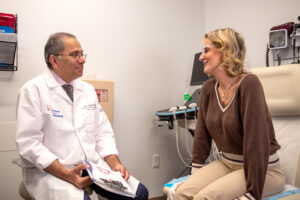 Kathy will never forget that Easter Sunday when she went to pick up her mother for church. Her mom answered the door, all dressed and ready to go, but there was one thing out of place. Her mother’s smile was crooked.
Kathy will never forget that Easter Sunday when she went to pick up her mother for church. Her mom answered the door, all dressed and ready to go, but there was one thing out of place. Her mother’s smile was crooked.
“Oh, it’s nothing,” her mom assured her when Kathy asked about it. “I just noticed it when I looked in the mirror earlier. It’s just numb, but it doesn’t hurt. I’m sure it will go away soon.” It did go away. After an hour, Kathy noticed that her mother’s mouth was back to normal. That little droop on the right side of her bottom lip was gone.
As she drove her mother toward home, that crooked smile kept bothering Kathy. It just didn’t seem right. So despite her mother’s protests, Kathy made a detour to the hospital emergency department nearby. It was a good thing she did, because her mother had experienced a TIA, a transient ischemic attack, also known as a “mini stroke.”
“A TIA is a warning. And it should be treated as such. Most people would go to the ED if they experience chest pain (which may herald an impending heart attack) but many ignore signs of an impending stroke,” stressed Dr. Frasat Chaudhry, a neurologist with Phelps Hospital.
Although a TIA does not always precede a full-blown stroke, it often does. Strokes are of two main types: ischemic, which is usually caused by a clogged blood vessel, and hemorrhagic, which is caused by a rupture of a small blood vessel. About 87 percent of strokes are ischemic and 13 percent are hemorrhagic.
May is National Stroke Awareness Month, so this is a good time to educate yourself about the signs of stroke and how to prevent one. It is also important to learn how strokes are treated and who to contact if you believe you or a loved one is experiencing a TIA or a stroke. Being treated at a certified stroke center can make the difference between life and death or between high- and low-functionality following a stroke.
The Stroke Center at Phelps Hospital in Sleepy Hollow has received the Stroke Gold Plus Quality Achievement Award from the American Heart Association/American Stroke Association. The award recognizes the hospital’s commitment to ensuring stroke patients receive the most appropriate treatment according to nationally recognized, research-based guidelines. The association also placed Phelps on its Target: Stroke Elite Plus Honor Roll. To qualify for this recognition, hospitals must meet quality measures developed to reduce the time between the patient’s arrival at the hospital and treatment with the clot-buster tissue plasminogen activator, or tPA, the only drug approved by the U.S. Food and Drug Administration to treat ischemic stroke.
Know the signs of TIA and stroke: sudden onset of severe headache; confusion; trouble speaking or seeing; and numbness or weakness, especially on one side of the body. If you think you are experiencing a TIA or stroke, immediately call 911, wait for the ambulance, and go to the nearest emergency room, ideally one that has a stroke center.







I never knew about how TIA, a transient ischemic attack, is also known as a mini-stroke, and it a clear warning that it should be treated. My parents are old and they do not live very healthy lifestyles as our we love our food, and it’s cooked using a lot of oil. You mentioned that a TIA does not always lead up to a stroke, but knowing that it often does is a definite cause of concern. I will be sure to let my parents know to be vigilant about TIA including sudden headache, confusion, and especially numbness or weakness on one side of the body. I will also do my due diligence and look for a stroke doctor who is available 24/7 here in New York in case of an emergency.
Thanks for writing this awesome article. I’m a long time reader but
I’ve never been compelled to leave a comment. I subscribed to
your blog and shared this on my Twitter. Thanks again for a great article!